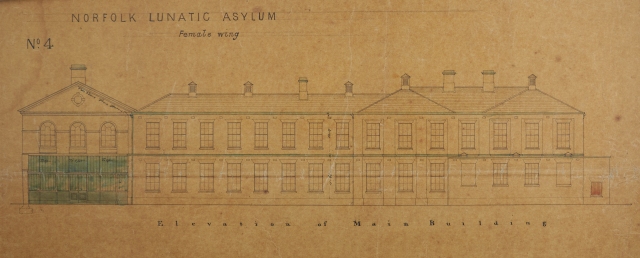Mental health issues are a feature of modern life and the archive of Norfolk Lunatic Asylum, or St Andrew’s Hospital as it was renamed in the 1920s, shows this is not new. It is interesting to compare the ‘causes of insanity’ in the 19th century with the causes of stress and depression cited nowadays.

Female wing, c. 1857. NRO, SAH 794
If we examine the case histories of patients admitted to Norfolk Lunatic Asylum in the years 1845-1870, the female admissions were 25% higher than that of males. Looking at the possibility of gendered diagnoses, i.e. conditions that were peculiar to women, 12% of female patients were diagnosed with insanity assigned to female issues. Most of those related to the process of childbearing: accouchement, childbirth, confinement, lactation, miscarriage, parturition, pregnancy, puerperal and suckling child, which accounted for 7% of all female admissions.
The term puerperal insanity describes the condition that developed in women before, during or after the process of childbirth and the multiplicity of symptoms associated with this condition are quoted as being: ‘sleeplessness, rapid pulse, pallor or flushed skin, vivid eyes, furred tongue, constipation and delirium, …. great excitability, expressed through constant chattering, delusions, singing, swearing, tearing clothes and lewd sexual displays.’[i]
Medical superintendents were reporting a growing number of patients with this condition in county lunatic asylums throughout the country and their experience linked the symptoms with ‘moral’ issues such as poverty, physical exhaustion, malnourishment or, as they would now be termed, social problems.
Extending the period of lactation when their physical health was frail could result in insanity among women. According to the case books for Norfolk Lunatic Asylum, two patients were admitted in July 1863 and July 1864 with acute mania, the cause being recorded as superlactation: Elizabeth D had been suckling a child of two years old as well as a baby of seven months old which had ‘much reduced her strength, and to this her mental derangement is attributed’, whilst Mary H had also been suckling her youngest child for almost two years ‘causing her to become excessively weak.’ Both mothers were discharged recovered after only two months and five months respectively. (NRO, SAH 263)
Hannah H was admitted for the first time at the age of 38 in 1866 when it was recorded that she was the mother of ten children. (NRO, SAH 264). By the time of her third admission in 1870 she was the mother of twelve. At the time of her sixth admission in 1874 the case book entry recorded ‘No known exciting cause. Patient has not suffered privation her husband being in employment and well-paid.’ (NRO, SAH 265). Although Hannah H’s husband had been in ‘well-paid employment’ as a railway labourer she must have been severely strained to feed and clothe her family adequately on his wages. The intervals between attacks shortened and the time she spent in the asylum increased although the pattern of her illness was unchanged; on admission she was restless, excited, noisy and destructive but within weeks she became good tempered, rational and quiet.

Hannah H. Case book, St Andrew’s Hospital (NRO, SAH 265)
This was frequently the result for many patients; just a short period of respite within the Asylum, away from the endless struggle of daily life, and their physical and mental health improved immeasurably. Some women’s symptoms mirrored those associated with the malady now termed post-natal depression, but rest and regular meals quickly improved their mental health as well as their abysmally poor physical condition.
In her book The Female Malady, Elaine Showalter suggests it is ‘the suffocation of family life, boredom and patriarchal protectivism’ which ‘gradually destroys women’s capacity to dream, to work, or to act.’[ii] However, within the casebooks of the Norfolk Lunatic Asylum there is no evidence that women admitted with puerperal insanity had feelings of frustration or confinement stemming from an inability to pursue activities of a more fulfilling nature. Their issues were connected with the pressures of daily living: poverty, ill health, domestic problems, work and/or the lack of it, and the asylum provided just that: asylum, in other words a refuge, from the struggles of daily living.
There are many personal tragedies contained within the records of St Andrew’s Hospital.
Compiled by Julie Jakeway, NRO Research Blogger
[i] H. Marland, ‘At home with puerperal mania: the domestic treatment of the insanity of childbirth in the nineteenth century’, in P. Bartlett and D. Wright (eds), Outside the Walls of the Asylum, The History of Care in the Community 1750-2000, (London, 1999), p. 52.
[ii] Showalter, The Female Malady, (London, 1985)














Another interesting article by Julie Jakesy
LikeLike
I take it you’ve read Julie’s earlier post?
LikeLike
We have so much to learn from these historical accounts both from the lunatic asylums and the workhouses. Thank you
LikeLike
Please can I be told if there are any cases, shown in the SAH files, of admission to St. Andrews of women from Melton Constable 1880 – 1948
LikeLike
Hi Adrian. Unfortunately the SAH files are not indexed to this level and would need to be consulted in the searchroom in order to find out if any of the patients were from Melton Constable. It is also worth noting that many of these records have restricted access for 100 years after the last entry so are not open access. You can see more information about the level of access for individual records on the Norfolk Record Office catalogue:http://nrocat.norfolk.gov.uk/DServe/dserve.exe
LikeLike